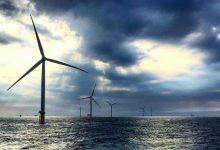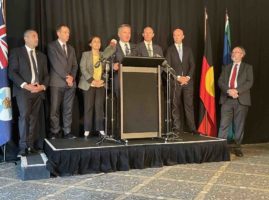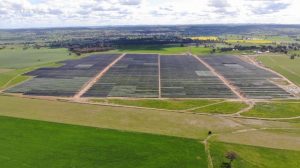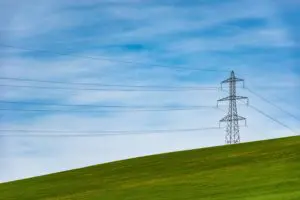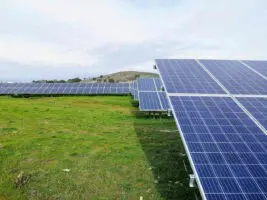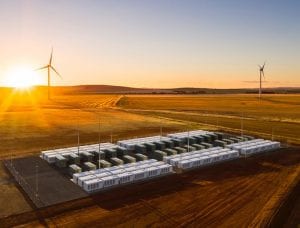Alinta is planning to build a huge 1 gigawatt offshore wind farm to tap into Australia’s main grid – the first major utility in the country to make such a commitment – as part of a massive spending spree on renewables and storage.
CEO Jeff Dimery says Alinta is also poised to announce the first big wind farm to be built in the Pilbara in north west Australia – possibly around 300MW – to help meet growing demand by industrial customers in the region for low and zero carbon energy supplies.
The revelations were made in an interview on RenewEconomy’ weekly podcast, Energy Insiders, where Dimery also spoke of the opportunities in pumped hydro, and battery storage, and commented on the introduction of 5-minute settlements and the failure to agree on na capacity mechanism the company favours.
But the big news is the planned 1GW “plus” offshore wind project, which will likely form a centrepiece of a planned $6 billion investment in renewables and storage. Dimery said he couldn’t reveal any details about either the location or the major customer, because the final agreement had yet to be signed.
“We believe, fundamentally, that to replace coal fired generation, we’re going to need large scale offshore wind,” Dimery said. Alinta owns the Loy Yang B brown coal generator in Victoria, and other gas generation and renewable and battery projects across the country.
“We think it’s the most exciting of any offshore wind project, but like you’ve highlighted, it’s a race.”
Asked if it was to be in NSW, Victoria or Tasmania, Dimery would not say. He did say it would be in shallow waters rather than a floating facility in deeper waters, which suggests that southern Victoria or Tasmania is most likely.
Dimery also said it was not a previously identified project. About 12 different potential offshore wind farms have been identified in Australia, with the 2GW Star of the South project off Gippsland in Victoria seen as the most advanced.
See RenewEconomy’s Offshore Wind Farm Map of Australia
Offshore wind is now seen as the big new play in key overseas markets such as Europe, the US and Asia, but it remains more expensive than onshore wind and solar, even though its costs are coming down. Asked about these cost issues, Dimery said:
“We we know all of that, David, and we’re still very excited. There are ways to deal with certain things, and I just can’t go any further.
“But I’m not into wasting my time and my development team’s time. We’re spending a lot of money on capital at this point to make this a reality. And we wouldn’t do it if we didn’t think it wouldn’t be economic.”
Dimery also said Alinta is looking at a major wind farm investment in the Pilbara, where its big industrial customers are seeking cheaper, low emissions renewables in their energy supply.
“We’re seriously looking at the connection of a wind farm developments up in the Pilbara, and we’re looking at across a number of sites around 300MW,” Dimery says. “We think around 300MW is eminently doable.”
Alinta already operates a major gas plant and is looking at adding a solar farm and a new big battery in the Port Hedland network, which is loosely connected to the private network it operates out of Mt Newman, where it has another gas generator, its first big battery, and a newly opened solar farm at Chichester.
This Mt Newman network supplies power to the iron ore mines operated by billionaires Andrew Forrest and Gina Rinehart.
Such a wind farm might be a first for the Pilbara region, but it won’t be the last. Forrest is looking at wind energy to boost its access to renewables, as well as for its massive green hydrogen plans.
CWP and Intercontinental is also looking at a 26GW facility combining wind and solar, but mostly wind, for the Asian Renewable Energy Hub that will look to supply green ammonia and hydrogen to Australian and international customers.
Dimery also talked of his company’s interest in the big Ovens Mountain pumped hydro project in NSW, which will link in with neighbouring wind and solar projects and likely form part of the state government’s renewable infrastructure roadmap.
He also admitted his company’s assets had been “caught out” by spikes in the market after the introduction of five minute settlements, and lamented the failure of state and federal energy ministers to agree on a proposed capacity market mechanism that his company supported.
“I didn’t read any submissions that espoused prolonging the life of coal,” Dimery said.
“I did read submissions that were, if you like, aimed at making sure that coal wasn’t prematurely retired from the market. And I don’t think there should be any apology for that, because that the transition needs to be smooth, it needs to be affordable.”
See also: “We’ve been caught out:” Switch to 5-minute settlement traps market turtles

